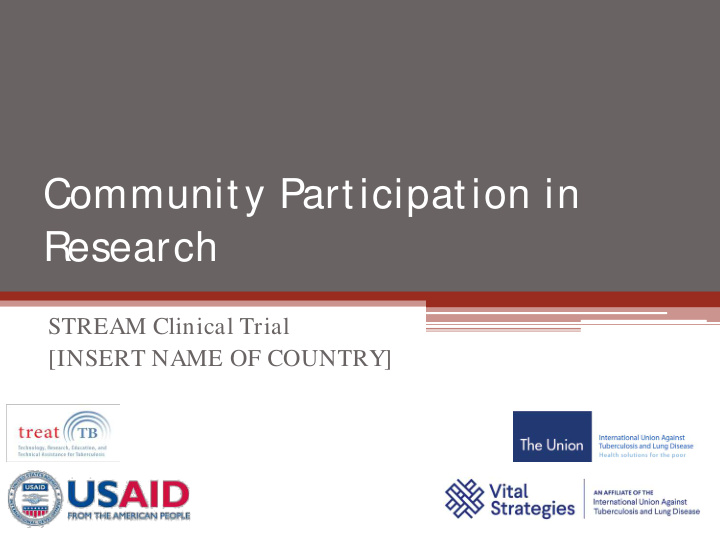



Community Participation in Research STREAM Clinical Trial [INSERT NAME OF COUNTRY]
2 Why do we need medical research? • It is the only way we have of accumulating evidence (proof) to improve treatment of TB • To find out if a new medicine or combination of medicines is safe and effective ▫ Does it work better than what we have? ▫ Does it have serious side effects?
3 How is medical research done? • Phase I: Researchers test a new drug or treatment in a small group of people for the first time to evaluate its safety, determine a safe dosage, and identify side effects. • Phase II: The drug or treatment is given to a larger group of people to see if it is effective and to further evaluate its safety. • Phase III: The drug or treatment is given to large groups of people to confirm its effectiveness, monitor side effects, compare it to commonly used treatments, and collect information that will allow the drug or treatment to be used safely. • Phase IV: Studies are done after the drug or treatment has been introduced to gather information on the drug's effect in various populations and any side effects associated with long- term use.
4 How is medical research done? • Before any research is done, a protocol is written and approved • The investigator(s) decide how to measure whether a medicine or treatment is working (efficacy) and is safe
5 What is in a research protocol? Objectives and purpose Statistical Design and endpoints considerations Quality assurance and Enrollment control Study agent (e.g., Ethics/ protection of medicine) participants Study procedures and Data handling and schedule record keeping Assessment of safety Study administration Clinical monitoring
6 How is clinical research approved? • Every research study requires approval from one or more scientific/ institutional review boards to ensure: the study protocol upholds principles of ethical research o Autonomy o Beneficence o Non maleficence o Justice there is current equipoise in the current scientific knowledge • Each country has its own system and review process
7 How is clinical research approved? • Every study also requires approval from the medicines regulatory authority, e.g., Food and Drug Administration, European Medicines Agency • Each country has its own system and review process
8 What is the role of CE in research? • Community engagement is a cornerstone of ethical medical research “ Concrete engagem ent w ith “ …. com m unities m ust have com m unities is needed from the space to participate in all TB scientists at each step TB research as m ore than of the R&D process, just trial participants” particularly in the p retria l and p ost-tria l phases.” The evolving role of advocacy in tuberculosis; Lancet Res Med. 2014;2(4):258–59.
9 When can communities participate in research?
10 Why community engagement ? • CE benefits communities An opportunity to learn about MDR-TB and trials • Understand MDR-TB, STREAM trial protocol, scientific language An opportunity to influence trial design and implementation • Ensure community views about the study are taken into account and participants benefit from the trial Maximize benefits to community after trial completion • Influence changes to policy arising from trial results
11 Why community engagement ? • CE can improve trial results An opportunity to ensure study is acceptable to community • Provide potential solutions for roadblocks in trial • Improve recruitment and retention Legitimacy and acceptance of trial results • Community involvement can ensure results are translated into policy change
12 Government Community ministries: Representatives: Ministry of Health, [Insert key [other government stakeholders] stakeholders] S TREAM S takeholders Funder: US AID Local S cientific S ponsor: The Union Community: [Insert Trial Management name of site] Group: MRC
13 How does CE work? • A mechanism is formed to lead/ coordinate community input into the study • Participants can include some or all of: Activists Affected populations Infected populations Direct service providers Researchers Government officials • TB program officers • District, municipal or provincial health authorities
14 How does CE work? • There are many forms of coordinating mechanisms: Specific committee or board (“Community Advisory Board” or CAB) formed for the study Pre-existing CAB that was formed for more than one research study Informal working groups Other mechanisms • Not “one size fits all”
15 How does a CAB work? • Local CAB coordinator(s)/ focal point(s) are chosen by stakeholders Very committed (dedicated to the cause) Available Disposed to communicate, network Institutional/ organizational support • A CE work plan is developed • A budget for the CE work plan is developed • Trial staff provide technical assistance (support for CAB activities)
16 What are typical CE activities? • Regular meetings of CAB and trial staff Trial staff update CAB regarding trial progress CAB provides community feedback to the trial team • Trainings For CAB members TB, MDR-TB and research • Community outreach CAB educates community regarding TB, MDR-TB and STREAM
17 Closing observations and questions • AIDS clinical research is better-funded than research for other diseases, including TB Why? How can STREAM CE help to change this? There is much more media attention on HIV/ AIDS than TB (even though the global burdens of HIV/ AIDS and TB are about equal) Why? How can STREAM CE help to change this?
Thank you
Recommend
More recommend